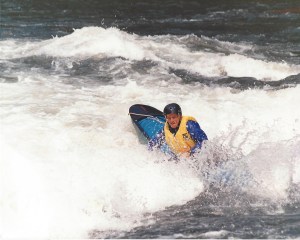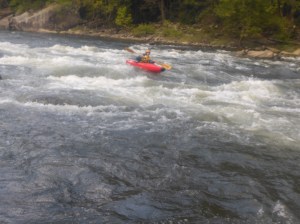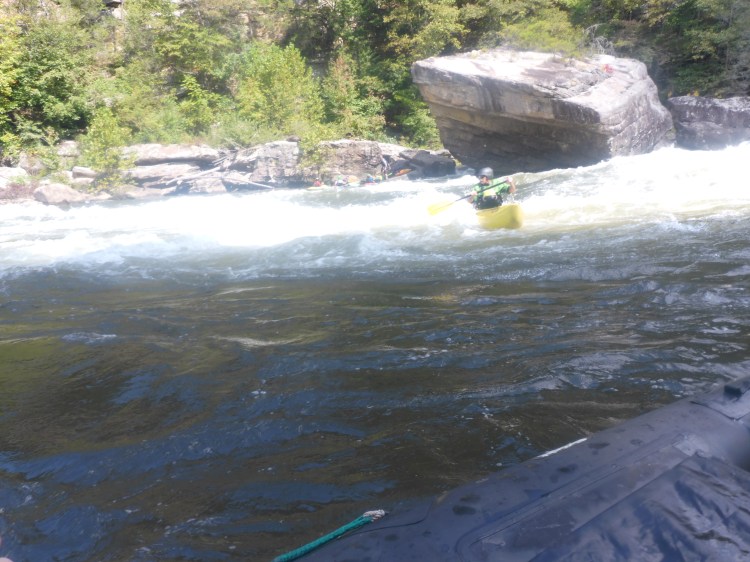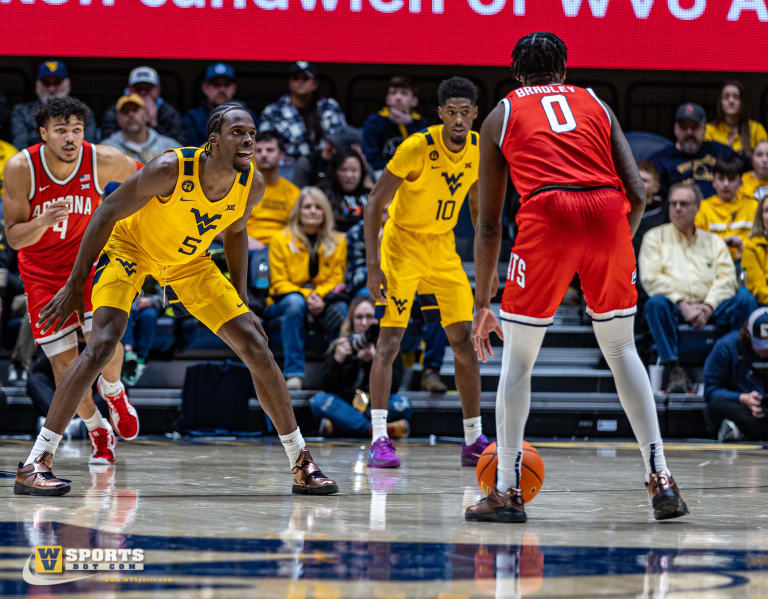A canoeist rides the waves at the bottom of Lower Mash. Ron Chase photos
In my opinion, West Virginia has more outstanding whitewater than any state east of the Mississippi. For nearly two decades beginning in 1990, my friends and I traveled to West Virginia almost every spring and fall to challenge its steep rivers and creeks. Then we got old, some passed, and we stopped making the semi-annual pilgrimages.
Probably no river better exemplifies West Virginia whitewater than the Gauley River near Summersville. A National Recreation Area, the Gauley offers world-class whitewater as it flows for over 25 miles through a succession of scenic gorges and valleys. Each fall, special high-volume releases are discharged from the Summersville Dam that attracts whitewater enthusiasts from all over the globe.
This year, my friend, Ryan Galway, planned a Penobscot Paddle & Chowder Society West Virginia whitewater trip that began with the Gauley River. When Ryan invited me, I was hesitant. Seventeen years have passed since I kayaked the Gauley; my skills have diminished, and my Eskimo roll is less reliable. Ryan suggested joining him on a shredder, a more forgiving, two-person inflatable boat. Since my life insurance policy is paid up, I accepted the invitation.

A canoeist surfs Five Boat Hole on the Gauley.
Following a demanding 950-mile drive, I joined Ryan and eight more paddlers at the Gauley takeout in Belva. Ryan hired Hills to Hills Shuttle Service to transport us about 15 miles upriver to the put-in for the Lower Gauley at a location called Woods Ferry. The water level approximated a feisty 3,000 cubic feet per second. The launch area was bustling with activity.
We anticipated an extremely exciting day. Consisting of five kayaks, two canoes and the shredder team, most of the group had never paddled the Gauley. Ryan and I were experiencing our first time shredding together. Ours would be on-the-job training.
After a few Class III rapids, we approached the first difficult descent called Backender. A long, chaotic rapid filled with large waves and huge holes, the preferred route is center to far left at the bottom to avoid the gnarly back ender wave/hole. Ryan and I almost got back ended. A canoeist flipped and swam. We clearly needed to improve our game as Class V, Koontz Flume, was next.
Although there was some disagreement about how to navigate Koontz Flume, there was no doubt in my mind. Ryan and I intended to avoid holes and the dangerously undercut rock on the right by running tight left. Most followed us and everyone nailed it. A couple of boaters in our group surfed the famed Five Boat Hole at the bottom. Both flipped and rolled.
The next difficult rapids were Upper and Lower Mash. Upper is a complex trashy descent. Ryan and I negotiated around a maze of holes and pour-overs before plowing through a powerful hydraulic at the bottom. A canoeist in our group swam most of the rapid. When we assisted him to shore, he summed up his experience with a succinct comment, “I got mashed.” While helping him, two shredder teams swam past — a stark reminder we weren’t exempt from mishaps.

A kayaker navigates through Diagonal Ledges.
Descending Lower Mash required completing a difficult ferry to river left followed by a twisting route through huge waves. One canoeist walked. Everyone else experienced successful runs.
The next challenging rapid, Heaven’s Gate, is around the bend. Our group effectively navigated the center to left route before careening between or around two giant rocks at the end called Pearly Gate.
Several long rapids ensued, but our minds were focused on the last major descent, a Class V delightfully named Pure Screaming Hell. Remaining in your boat at the bottom requires riding large waves on the left, skirting a wide keeper hole to the right and then maneuvering hard left to miss a notorious obstacle called Hell Hole. A kayaker in front of us caught the edge of the keeper. He capsized and swam through enormous waves but missed Hell Hole. Ryan and I almost replicated his disaster but managed two last-second pry strokes to escape unscathed.
The last mile or so consists of easier rapids. At the takeout in Belva, we celebrated completion of one of the most demanding whitewater runs in the eastern United States. Tomorrow, we’re going to paddle another iconic West Virginia river, New River Gorge.
My book, “Maine Al Fresco: The Fifty Finest Outdoor Adventures in Maine,” narrates exciting descents of nine whitewater rivers and streams.
Ron Chase resides in Topsham. His latest book, “Maine Al Fresco: The Fifty Finest Outdoor Adventures in Maine” is available at northcountrypress.com/maine-al-fresco or in bookstores and through online retailers. His previous books are “The Great Mars Hill Bank Robbery” and “Mountains for Mortals — New England.” Visit his website at ronchaseoutdoors.com or he can be reached at ronchaseoutdoors@comcast.net.

A paddler descends Koontz Flume.
« Previous
Related Stories























/cdn.vox-cdn.com/uploads/chorus_asset/file/25822586/STK169_ZUCKERBERG_MAGA_STKS491_CVIRGINIA_A.jpg)




/cdn.vox-cdn.com/uploads/chorus_asset/file/25821992/videoframe_720397.png)
Invalid username/password.
Please check your email to confirm and complete your registration.
Use the form below to reset your password. When you’ve submitted your account email, we will send an email with a reset code.